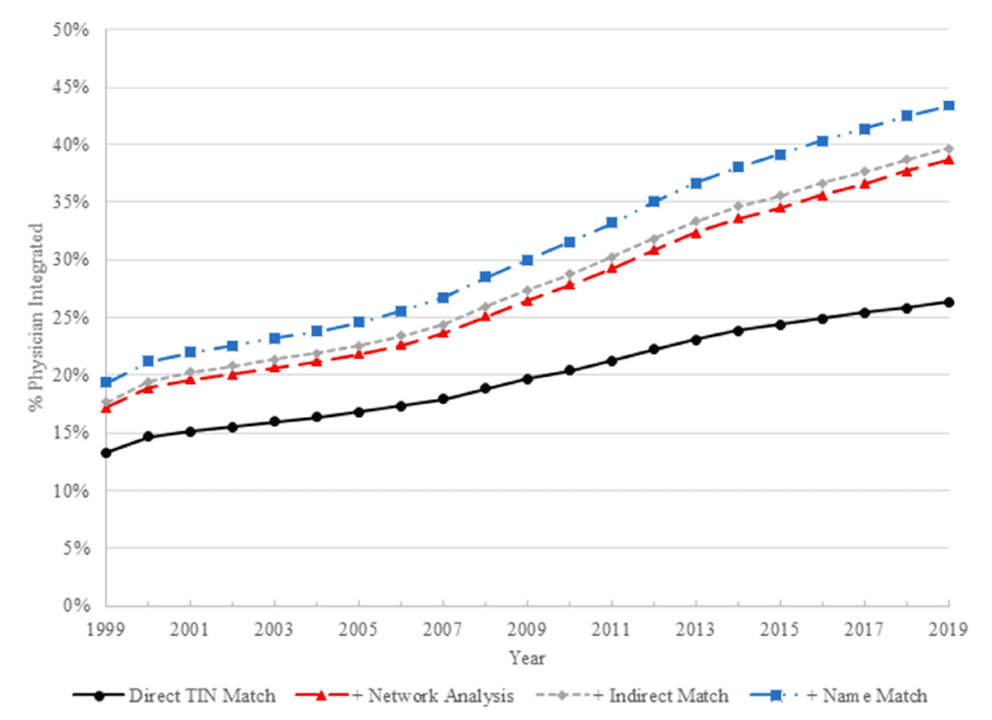What share of physicians are integrated within hospital systems?

This questions may be harder to answer than it may seem. While some physicians are fully independent, and others are full employees, other physicians can be affiliated with hospitals, without being hospital-employed.
There are various approaches for measuring whether a physician is integrated within a hospital system:
Basic TIN-based measure. The standard approach to identifying whether a physician is integrated into a hospital is to examine whether that physicians billed exclusively or primarily using a a tax identification number (TIN) that belongs to a hospital or a health system that operates hospitals (aka a “hospital-related TIN”)–those that are are deemed to be integrated. This approach is useful but relies on a comprehensive set of hospital TINs; without a comprehensive list, there are many false positives.Service location measure. A second approach uses examines how often outpatient services are performed in hospital-based outpatient departments versus physician offices. Physicians who perform all or most outpatient services in an hospital outpatient location are determined to be integrated. However, false positive can occur for nonintegrated physicians who use hospital outpatient facilities for selected procedures (e.g., surgeries); false negatives occur for integrated physicians who often provide outpatient services in a physician’s office. Affiliation based approaches. These approaches rely on the physicians affiliation rather than a billing based or place of service based approach to measure integration. Common data sources used to identify affiliation include a proprietary database from IQVIA (formerly SK&A); and the Compendium of U.S. Health Systems prepared by the Agency for Healthcare Research and Quality (AHRQ).“Advanced” TIN measure. This approach was proposed in a paper by Luo et al. (2024) and is similar to the Basic TIN-based measure as it relies on 3 steps: “(i) a multistep search for hospital-related TINs using multiple sources for these TINs ; (ii) using Medicare data to determine the TINs that physicians use to bill for services; and (iii) identifying as integrated those physicians who bill Medicare primarily (75% or more) or exclusively using hospital-related TINs.” The authors also examine whether hospitals have a controlling interest in the physician TIN (based on IRS data), which they call they “network” approach’; using data from AHA surveys to link hospitals and physicians (“indirect” approach).
Using these approaches, Luo and co-authors find that the number of physicians who are integrated into hospitals is rising over time. The “Direct TIN match”–which is analogous to the Basic TIN-based measure describe above, shows that the share of physicians integrated into hospitals increased between 1999 and 2019. However, this figure peaks at just over 25%. If we bring in Luo et al.’s other methods for measuring physician vertical integration, we not only find that the share of physicians integrated into hospital-based systems is much higher, but the trend is much steeper. Specifically, the authors find that:
There was a steady increase in percent of physicians integrated from 19.5% of physicians in 1999 to 24.6% in 2005 and 43.5% in 2019.
https://pubmed.ncbi.nlm.nih.gov/38689535/
You can read more details on this study here. A methods summary figure is below.
 https://pubmed.ncbi.nlm.nih.gov/38689535/
https://pubmed.ncbi.nlm.nih.gov/38689535/
The
views expressed herein are those of the author and not necessarily the views
of FTI Consulting, Inc., its
management, its subsidiaries, its affiliates, or its other professionals.




